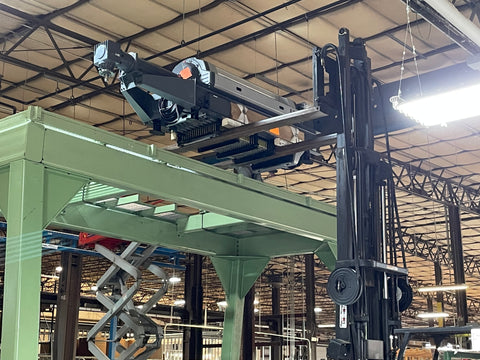Say Hello to Our New Matelasse Loom!
Big things have been happening at our mill over the last few months! We welcomed a brand new Jacquard matelasse loom into our Monmouth Maine manufacturing facility, Maine Heritage Weavers. This project has been in the works for some time, so we are very excited to see everything come to fruition.

As you may know, many of our looms still run on the old Jacquard punch cards - which, by today's standards, is pretty outdated technology. While we take pride in keeping our old looms running, adding this new digital loom to our production floor will allow us to weave our classic matelasse bedspreads at a much faster rate. In addition, we won't have to worry about making and storing all of the punch cards, since this loom weaves designs from digital files.

Our oldest Jacquard head still in production that uses punch cards to dictate the design.
Read on to learn about each step in the loom installation process!
1| Building the Gantry

First, we needed to construct a large structure called a gantry. What sets jacquard looms apart from other looms is the "jacquard head". This essential machine controls the complex patterns the loom weaves. The gantry holds the jacquard head in place above the loom.
2| Placing the Jacquard Head
Next, the jacquard head had to be situated in the correct location on top of the gantry.


3| Installing the Loom
Once the jacquard head was secured on top of the gantry, the loom itself had to be installed underneath. It arrived at our facility early in the morning, and after a winding ride through our production floor, it was pushed into place by some members of our crew.


It was then time for the loom and the head to be connected to each other. The photo below shows these connecting "lines" being installed. Each line is controlled individually by the jacquard head and has a corresponding warp thread that it either lifts or lowers, depending on the pattern. This allows each warp thread on a jacquard loom to work independently - ultimately, this means the patterning capabilities of a jacquard loom are limitless!

4| Installing the Warps & Sleying the Reed
Before we could actually weave on the loom, the warps needed to be tied in. There are two warps involved in our matelasse weaving: a top warp and a bottom warp. After being tied on, the ends from both warps needed to be brought to the front of the loom, where they are drawn through the loom reed in a specific sequence. This is known as sleying the reed. The reed separates the warp threads during weaving, and it also beats the weft (or horizontal threads in weaving) into place.


5| Test Weaving
Finally, we were ready to test weave! Can you guess which one of our matelasse bedspreads we started with?

Interested in learning more about our manufacturing process? Follow our sister page Maine Heritage Weavers on Facebook and Instagram!
